ARF1 compartments direct cargo flow via maturation into recycling endosomes
- PMID: 39367144
- PMCID: PMC11567898
- DOI: 10.1038/s41556-024-01518-4
ARF1 compartments direct cargo flow via maturation into recycling endosomes
Abstract
Cellular membrane homoeostasis is maintained via a tightly regulated membrane and cargo flow between organelles of the endocytic and secretory pathways. Adaptor protein complexes (APs), which are recruited to membranes by the small GTPase ARF1, facilitate cargo selection and incorporation into trafficking intermediates. According to the classical model, small vesicles would facilitate bi-directional long-range transport between the Golgi, endosomes and plasma membrane. Here we revisit the intracellular organization of the vesicular transport machinery using a combination of CRISPR-Cas9 gene editing, live-cell high temporal (fast confocal) or spatial (stimulated emission depletion) microscopy as well as correlative light and electron microscopy. We characterize tubulo-vesicular ARF1 compartments that harbour clathrin and different APs. Our findings reveal two functionally different classes of ARF1 compartments, each decorated by a different combination of APs. Perinuclear ARF1 compartments facilitate Golgi export of secretory cargo, while peripheral ARF1 compartments are involved in endocytic recycling downstream of early endosomes. Contrary to the classical model of long-range vesicle shuttling, we observe that ARF1 compartments shed ARF1 and mature into recycling endosomes. This maturation process is impaired in the absence of AP-1 and results in trafficking defects. Collectively, these data highlight a crucial role for ARF1 compartments in post-Golgi sorting.
© 2024. The Author(s).
Conflict of interest statement
Figures
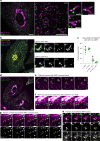


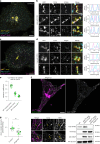
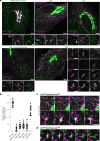

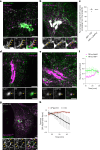


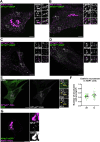
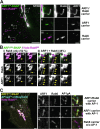


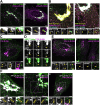

Similar articles
-
ARF1 and ARF3 are required for the integrity of recycling endosomes and the recycling pathway.Cell Struct Funct. 2012;37(2):141-54. doi: 10.1247/csf.12015. Epub 2012 Sep 5. Cell Struct Funct. 2012. PMID: 22971977
-
Transport of the cholera toxin B-subunit from recycling endosomes to the Golgi requires clathrin and AP-1.J Cell Sci. 2015 Aug 15;128(16):3131-42. doi: 10.1242/jcs.172171. Epub 2015 Jul 1. J Cell Sci. 2015. PMID: 26136365
-
ARF1 and ARF4 regulate recycling endosomal morphology and retrograde transport from endosomes to the Golgi apparatus.Mol Biol Cell. 2013 Aug;24(16):2570-81. doi: 10.1091/mbc.E13-04-0197. Epub 2013 Jun 19. Mol Biol Cell. 2013. PMID: 23783033 Free PMC article.
-
Cargo adaptors: structures illuminate mechanisms regulating vesicle biogenesis.Trends Cell Biol. 2015 Jul;25(7):408-16. doi: 10.1016/j.tcb.2015.02.005. Epub 2015 Mar 17. Trends Cell Biol. 2015. PMID: 25795254 Free PMC article. Review.
-
Conformational regulation of AP1 and AP2 clathrin adaptor complexes.Traffic. 2019 Oct;20(10):741-751. doi: 10.1111/tra.12677. Epub 2019 Aug 6. Traffic. 2019. PMID: 31313456 Free PMC article. Review.
Cited by
-
Amyloid-β disrupts APP-regulated protein aggregation and dissociation from recycling endosomal membranes.EMBO J. 2025 Aug;44(16):4443-4472. doi: 10.1038/s44318-025-00497-y. Epub 2025 Jul 17. EMBO J. 2025. PMID: 40676215 Free PMC article.
-
A Commander-independent function of COMMD3 in endosomal trafficking.Elife. 2025 Aug 21;14:RP105264. doi: 10.7554/eLife.105264. Elife. 2025. PMID: 40838988 Free PMC article.
-
A CRISPR/Cas9 screen reveals proteins at the endosome-Golgi interface that modulate cellular anti-sense oligonucleotide activity.Nat Commun. 2025 Jun 30;16(1):5378. doi: 10.1038/s41467-025-61039-y. Nat Commun. 2025. PMID: 40588516 Free PMC article.
-
Induced degradation of SNAP-fusion proteins.RSC Chem Biol. 2024 Oct 21;5(12):1232-47. doi: 10.1039/d4cb00184b. Online ahead of print. RSC Chem Biol. 2024. PMID: 39444693 Free PMC article.
-
A Commander-independent function of COMMD3 in endosomal trafficking.bioRxiv [Preprint]. 2025 Apr 1:2024.12.12.628173. doi: 10.1101/2024.12.12.628173. bioRxiv. 2025. Update in: Elife. 2025 Aug 21;14:RP105264. doi: 10.7554/eLife.105264. PMID: 39763841 Free PMC article. Updated. Preprint.
References
-
- Robinson, M. S. Forty years of clathrin-coated vesicles. Traffic16, 1210–1238 (2015). - PubMed
Publication types
MeSH terms
Substances
Grants and funding
- SFB958 Project A25/Deutsche Forschungsgemeinschaft (German Research Foundation)
- TRR186 Project A20/Deutsche Forschungsgemeinschaft (German Research Foundation)
- TRR186 project A08/Deutsche Forschungsgemeinschaft (German Research Foundation)
- HA 2686/24-1/Deutsche Forschungsgemeinschaft (German Research Foundation)
- TRR186 project Z02/Deutsche Forschungsgemeinschaft (German Research Foundation)
LinkOut - more resources
Full Text Sources
Research Materials
Miscellaneous

